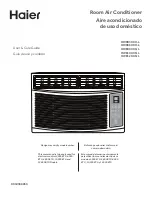
7 Installation
Installer reference guide
31
ERLQ004~008CA + 08S18CB
Daikin Altherma – Low temperature split
4P401676-1 – 2015.02
b
Factory refrigerant charge: see unit name plate
c
Additional refrigerant amount charged
d
Total refrigerant charge
2
Fix the label on the inside of the outdoor unit near the gas and
liquid stop valves.
7.8
Connecting the water piping
7.8.1
About connecting the water piping
Before connecting the water piping
Make sure the outdoor and indoor unit are mounted.
Typical workflow
Connecting the water piping typically consists of the following
stages:
1
Connecting the water piping of the indoor unit.
2
Connecting the pressure relief valve to the drain.
3
Filling the water circuit.
4
Filling the domestic hot water tank.
5
Insulating the water piping.
6
Connecting the recirculation piping.
7.8.2
Precautions when connecting the water
piping
INFORMATION
Also read the precautions and requirements in the
following chapters:
▪ General safety precautions
▪ Preparation
7.8.3
To connect the water piping
NOTICE
Do NOT use excessive force when connecting the piping.
Deformation of the piping can cause malfunctioning of the
unit.
To facilitate service and maintenance, 4 shut-off valves are provided.
Mount the valves on the water inlets and on the water outlets. Mind
their position. Orientation of the integrated drain and fill valves is
important for servicing.
NOTICE
This unit is designed for operation on 2 temperature zones:
▪ underfloor heating in the
main zone
(water
temperature 35°C), this is the zone with the
lowest
water temperature
,
▪ radiators in the
additional zone
(water temperature
45°C), this is the zone with the
highest water
temperature
.
1
Install the shut-off valves on the water pipes.
f
a
c
e
d
b
a
Space heating additional zone water out
b
Space heating additional zone water in
c
Domestic hot water out
d
Domestic cold water in (cold water supply)
e
Space heating main zone water out
f
Space heating main zone water in
NOTICE
It is recommended to install shut-off valves to domestic
cold water in and domestic hot water out connections.
Shut-off valves are field supplied.
NOTICE
To avoid damage to the surroundings in case of water
leakage, it is recommended to close the cold water inlet
shut‑off valves during periods of absence.
2
Screw the indoor unit nuts on the shut-off valves.
3
Connect the domestic hot water in and out pipes to the indoor
unit.
NOTICE
▪ A drain device and pressure relief device should be
installed on the cold water inlet connection of the
domestic hot water cylinder.
▪ To avoid back siphonage, it is recommended to install a
non-return valve on the water inlet of the domestic hot
water tank in accordance with the applicable legislation.
▪ It is recommended to install a pressure reducing valve
on the cold water inlet in accordance with the
applicable legislation.
▪ An expansion vessel should be installed on the cold
water inlet in accordance with the applicable legislation.
▪ It is recommended to install the pressure relief valve on
a higher position than the top of the domestic hot water
tank. Heating of the domestic hot water tank causes
water to expand and without pressure relief valve the
water pressure inside the tank can rise above the tank
design pressure. Also the field installation (piping,
tapping points, etc.) connected to the tank is subjected
to this high pressure. To prevent this, a pressure
relieve valve needs to be installed. The overpressure
prevention depends on the correct operation of the field
installed pressure relief valve. If this is NOT working
correctly, overpressure will deform the tank and water
leakage may occur. To confirm good operation, regular
maintenance is required.
7.8.4
To connect the recirculation piping
Prerequisite:
Only required if you need recirculation in your system.
1
Loosen and remove the 4 screws that fix the top panel.
2
Remove the top panel from the unit.
4×
3
Connect the recirculation piping to the recirculation connection
(b) and route the piping through the hole at the backside of the
unit (a).
















































